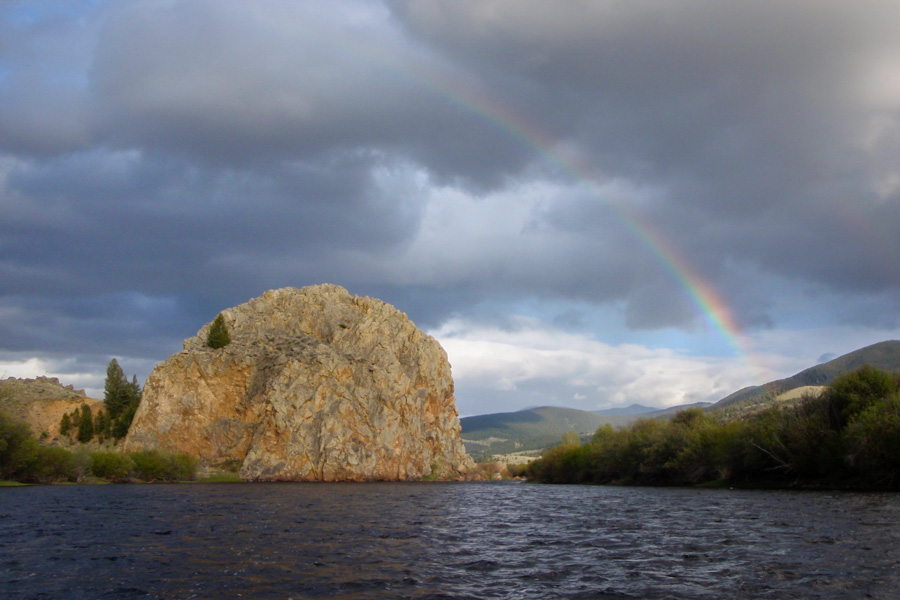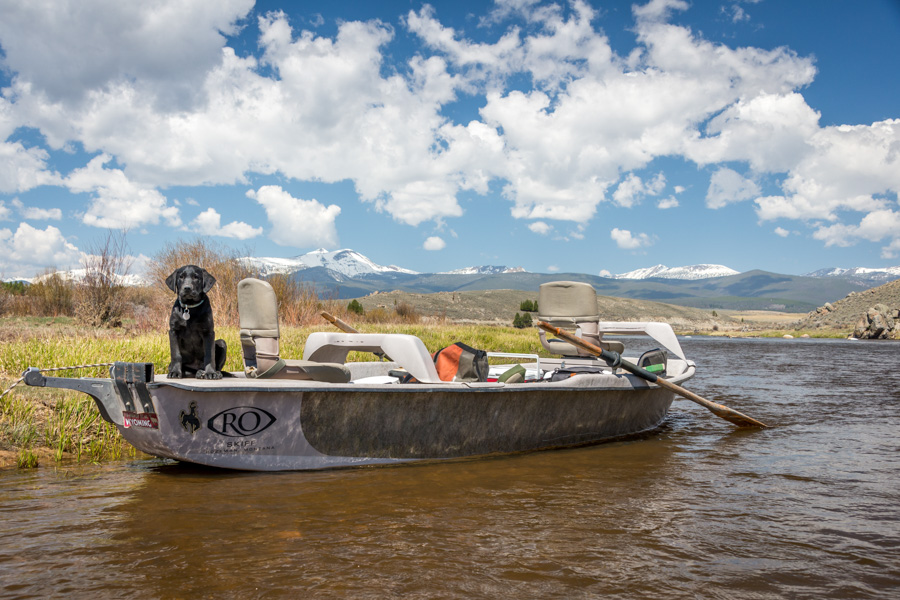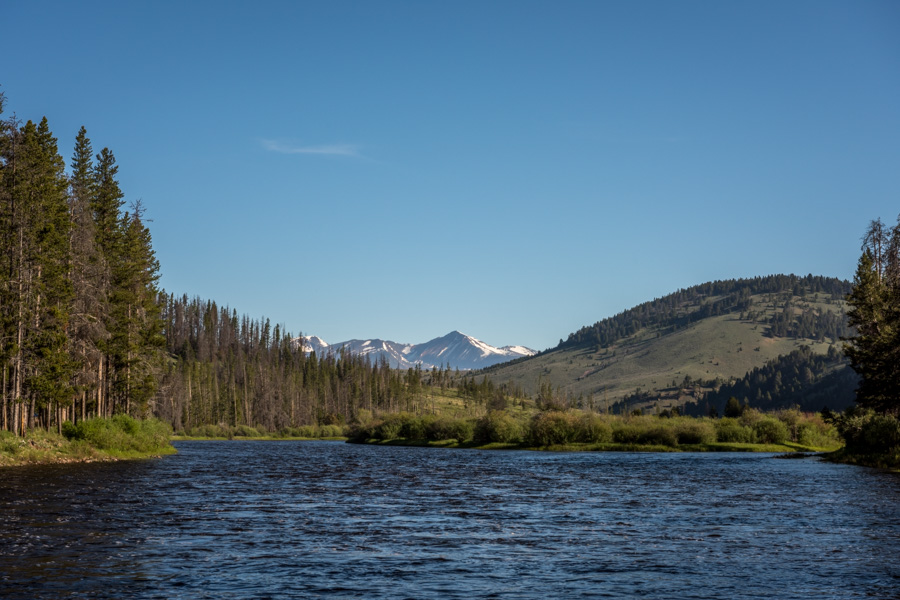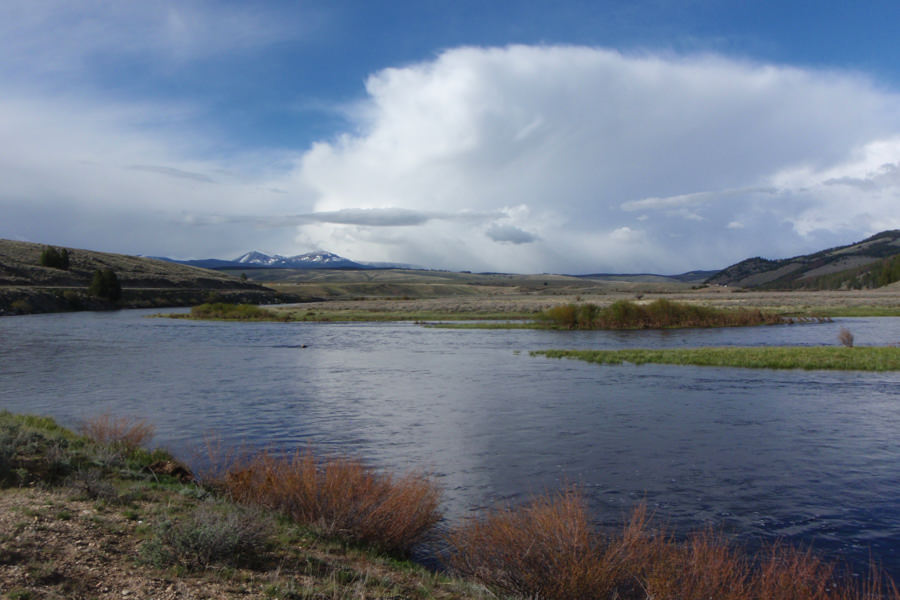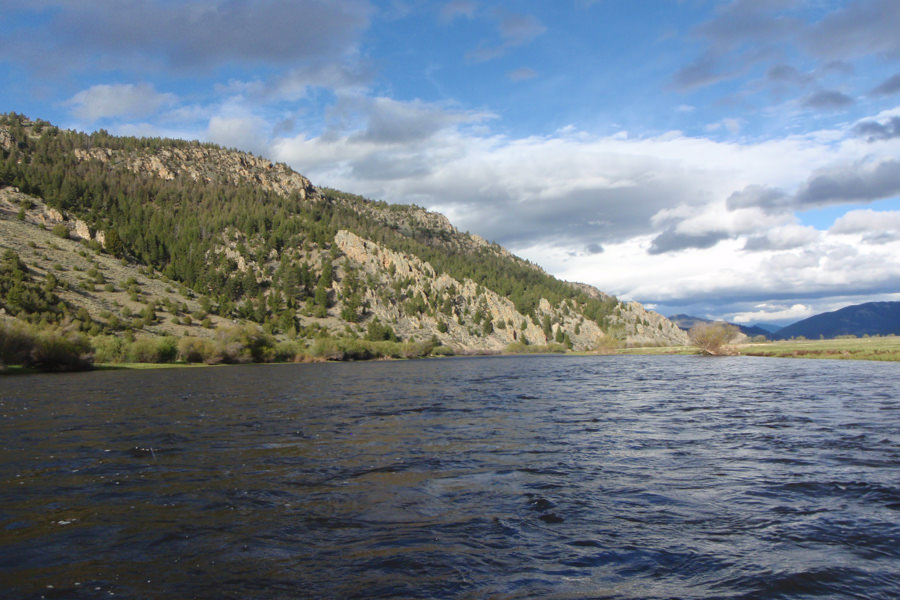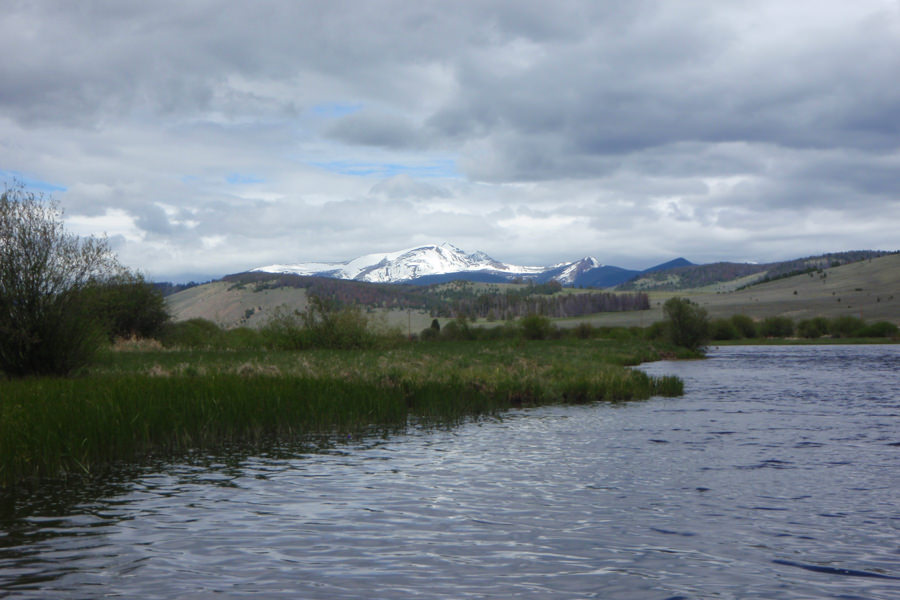The natives first named the Big Hole Valley the Land of Big Snows and Ground Squirrel Valley. Captain Meriwether Lewis of the Lewis and Clark Expedition named the forks of the Jefferson River, Wisdom and Philanthropy, to honor President Jefferson's virtues. Later on the return trip, William Clark would name the present area of Jackson the Hot Spring Valley when they camped for the night near the hot springs. Fur trappers seeking valleys (holes) gave it its lasting name. With the passing of time, ranchers would sprinkle the valley with rich hay fields, producing some of the finest hay in the region. Ranchers nicknamed the valley 10,000 Stacks Valley with the invention in 1910 of the Beaverside Haystacker. But by the late 1930s and 40s, the Big Hole achieved piscatorial preeminence from local fly fishers and then by fishermen from around the country who came to pay homage to another one of Montana's fluvial wonders.
The Big Hole River could just as easily have been named the Big Bend River. From its headwaters down to Jackson, the river, more aptly described as a small meadow stream, meanders northwards to Wisdom, Montana and then to Sportsman Park. From there the river heads east and then south to Melrose and Glen. From Glen the river runs east for a short distance and then heads north again to meet the Beaverhead and form the Jefferson River. From the town of Wisdom to Twin Bridges, the river winds a little over a 100 miles. The most famous section, particularly during the Salmon Fly hatch in mid-June, stretches from Divide to Glen. From the second week in June through the end of the month, this section of river rivals the Madison in its hey days for boat traffic. The run-off, typically beginning in May, makes the Big Hole most difficult and perhaps dangerous to wade fish with the arrival of the Salmon Fly hatch in early June. The powerful current and half-submerged sweepers and rocks pose serious consequences for inexperienced rowers as well. Early July brings the arrival of the golden stoneflies, caddis and mayflies. With the arrival of mid-summer, irrigation drawdown and slow, heated water shuts the river down in some sections. In drought years the trout are barely able to survive in these sections of the river, and playing a fish to shore adds significant stress to their survival chances after release.
With the exception of the Salmonfly hatch, the Big Hole River provides lots of elbow room for anglers seeking some solitude. During early summer the Big Hole fishes well with attractor patterns, particularly in the upper stretches above and below Wisdom where anglers also have the opportunity to catch Arctic Grayling. The Big Hole River holds the last survivors of river-dwelling grayling in the lower 48 states, and their numbers are growing under the careful protection of the state after the severe drought years during the 1980s.
In addition to the grayling, the upper section holds high concentrations of brook trout and to a lesser extent cutthroats and rainbows. With the discovery in recent years of Whirling Disease, the verdict is still out on the rainbow population, but recent research holds promise for securing a place for rainbows in the drainage. The mid section of the river below Wise River picks up both volume and gradient speed as the river flows through canyons offering floaters a mixture of riffles, rocks and pockets. Larger rainbows and browns are found from the Divide Bridge down to Melrose, the most popular float on the river. Some sections of the Big Hole River have produced shock-counts of over 3,000 trout per mile.
From Glen to the confluence at Twin Bridges, the river returns to pasture land and cottonwood bottoms and braided channels. Check with one of the shops before you float this section as it often contains many obstacles and impediments to safe and fun floating. The river holds mostly browns hidden under downed trees and undercut banks. The lower stretch may be accessed from a county road from Glen to Twin Bridges, but there are no public access points except bridges and non-posted private land. Access to the upper river, on the other hand, has improved greatly thanks to the efforts of the Big Hole River Foundation.
Fishing the Salmon Fly hatch requires patience, luck and good oaring skills. The greatest challenge to fishing this river is to wait for your turn to launch your boat. The last time I floated from Divide to Melrose, almost ten years ago, I was shocked at the number of people waiting patiently and unpatiently to take their launch turn. Fishermen were dropping drift boats in the water everywhere. As I drifted down the river, I was reminded of all those nature films I had seen through the years of crocodiles charging through the marsh grass and silently entering the water. I suppose the best attitude to embrace for this bevy of boats is to just enjoy the circus-like parade and be as generous as possible in sharing the river, as once the hatch is over the crowds disappear for another year. The hatch moves typically four to five miles a day upstream from the confluence all the way up to Wisdom although the heaviest concentrations are from Glen to Wise River. The Salmon Fly hatch on the Big Hole is generally earlier than the hatch on the Madison. As a result the Big Hole draws outfitters and guides from all over the region, including from the Missoula area which offers a good Salmon Fly hatch on the forks of the Bitterroot, Rock Creek and the Blackfoot about the same time.
Nymph fisherman like to get ahead of the hatch, but the bulk of the fishermen enjoy fishing right in the middle of the hatch. Most of them enter the river between 9 AM and 10 AM hoping to catch the first ovipositing females as they warm up. Timing and good luck determines whether or not you will have a memorable hatch experience. Most camping fishermen come to stay for a while knowing that cold, rainy June days are a reality in southwestern Montana. About 20 years ago I fished the hatch for the first time with a former principal of mine from Jackson, Wyoming.
Nick Holmes, who at the time was the principal in Whitehall, Montana, almost always fished with a nymph. He was an excellent fisherman, and he would softly chuckle every time he watched me tie on a dry fly. Invariably he would out fish me. Nick had no use for strike indicators or tapered leaders. He carried a few spools of monofilament in his vest and tied on short leaders. As I was his junior, coupled with the fact that he always out fished me, I generally took Nick's advice, including switching over to a nymph after watching Nick land three or four fish. The night before I had driven over from the Bitterroot Valley and camped at Divide Bridge where I would meet Nick in the morning. I spent that first evening talking to every fisherman who would answer my questions. The general consensus was that it was not worth getting out on the river early until the bugs were warmed up and landing on the water. Eager beavers, I was told, just pass up good water that would be productive water later in the morning. I had planned on meeting Nick at 6 AM the next morning!
When Nick arrived earlier than our scheduled time, I was groggy eyed. I told him of my findings, and he let out that soft chuckle which from past experience assured me he had some experience that I wasn't about to challenge. It was chilly, but the sun was coming up when we backed up to the launch and slipped into the river at 7 AM. I was on the oars first and ribbed Nick about using a nymph today. "No," he said, "I'll fish with drys today. Here, I tied up a couple for you as well."
Tied would be an overstatement. Nick was also a goose hunter, and he had carved magnum salmonfly bodies out of balsa wood and attached them to what I guessed to be shark hooks. Richly painted and finished off with bright feathers, they looked more like floating Rappalas. As I received the two gigantic flies in my hands, Nick good naturally said, "Be sure to cut off about half of that tapered leader of yours." It was good advice. Our agreement was two fish caught and you are on the oars. Within ten minutes, Nick had landed his first trout of the day over 20 inches. Within the hour I was on the oars, and although my first two fish weren't quite as large as Nick's, I was jubilant. As the day progressed, we both lost our two hand-carved salmon flies and the fish became progressively smaller and tougher to catch. I never fished the Big Hole River again with Nick, and I have never carved balsa wood Salmon Fly patterns although each spring I wonder if they would work on Rock Creek. The Big Hole salmon fly hatch is a great experience if you time it right, if the run-off is not severe, and if the sky is free from pounding rain. But regardless of the conditions, fishing the legendary Big Hole is a great experience.
March and April: During this pre-runoff period, the river is best fished with a variety of woolly bugger and streamer patterns along with stonefly nymphs.
May: The month of May begins the run-off season along with prolific hatches of caddis. Unlike many of Montana's other famous rivers, the Big Hole does not typically get blown out with mud. If the weather cooperates, the upper and mid section is certainly worth fishing using Elk Hair Caddis patterns as well as emerging nymphs.
June: The Big Hole's famous Salmon Fly hatch is usually in progress by mid-June and essentially over by the end of the month with the exception of some late bloomers. Followed closely on the heels of the Salmon Fly hatch, Golden Stones and a few green drakes appear along with PMDs.
July: Early July offers opportunities for standard attractor patterns such as Humpies, Wulffs, Trudes, and Parachute Adams
Late Summer: Hoppers, ants and tricos
Fall: Hoppers, tricos, blue-wing olives, streamers and buggers.
Recommended Fly Fishing Lodge for the Big Hole River: Healing Waters Lodge
River description by David Archer
Tributaries
Access
Tributaries
Big Hole River - Highway 43
The Big Hole River may be reached via Highway 93 from Salmon, Idaho or from Interstate 15 from Idaho Falls to Butte or at the junction with Interstate 90 and Interstate 15 west of Butte. The Big Hole River parallels Highway 43, which begins at the junction with Highway 93 at Chief Joseph Pass. From the junction to Wisdom is 27 miles. Dillon is 93 miles.
MM=Mileage Marker signs
MM 16.5: Big Hole National Battlefield / North Fork: The Nez Perce, refusing to accept a re-negotiated treaty in which they would lose 9/10 of their reservation, refused to move into the newly restricted reservation. Tensions mounted, deadlines were mandated and a few young warriors precipitated military reprisals when they killed some settlers. Thus began a journey of flight and a series of skirmishes. The Nez Perce elected Chief Joseph as their leader. At the Big Hole the 7th US Infantry, under the command of Col. John Gibbon, mounted a surprise attack. The Nez Perce tribe suffered the loss of almost ninety members, only a third of whom were warriers. In military terms, the Indians had won the battle, but their loss of horses and provisions would soon exhaust them on their journey of escape. Thirteen hundred miles later, Chief Joseph would surrender to Col, Nelson A. Miles just 40 miles south of the Canadian Border.
"Hear me, my chiefs, I am tired; my heart is sick and sad. From where the sun now stands I will fight no more forever." Chief Joseph
The North Fork of the Big Hole River runs through the Battlefield and holds an abundance of brook trout.
MM 23: Lower North Fork Road / Mussigbrod Lake 18 miles, Pintler Lake 18: Mussigbrod Lake Campround (USFS) has 10 campsites. The lake fishes well for grayling and brook trout, but be prepared for ugly draw downs during the summer. Pintler Lake offers much more in scenery, good fishing from a boat and a small campground. The lake is between 30 and 40 acres and does not offer good fishing from the shoreline due to plant growth.
MM 26: Junction with Highway 278 to Dillon, Montana:
Highway 278 to Dillon
The route to Dillon leads to Jackson, Montana, which has a commercial hot springs. Seven miles south of Wisdom on Highway 278 is the turn off to Twin Lakes. Twin Lakes are sixteen miles from the highway. The lake, two lakes joined by a channel, is popular with locals and offers good fishing for rainbows and brook trout. Although large lake trout are present, their numbers seem to be in decline. Twin Lakes Campground has 21 camping sites and a boat launch.
From Wisdom to Jackson is 18 miles. Just out of Jackson a half of a mile is the turn off to Lower Miner Lake, which offers 18 campsites and a boat launch. The fishing, however, is only fair as the lake is shallow and suffers from oxygen depletion plant growth during the summer and periodic freeze-outs during the winter. Upper Miner Lake, along with Rock Island Lakes, offers good cutthroat and brook trout fishing for day hike fishing in the back country. The hike is approximately four to five miles and well worth the hike for the scenery alone. My sons and I have fond memories of catching lots of 9" brookies in these lakes.
Access
Highway 43
The Big Hole River may be reached via Highway 93 from Salmon, Idaho, from Interstate 15 from Idaho Falls to Butte or at the junction with Interstate 90 and Interstate 15 west of Butte.
The Big Hole River parallels Highway 43, which begins at the junction with Highway 93 at Chief Joseph Pass. From the junction to Wisdom is 27 miles. Dillon is 93 miles.
MM 16.5: Big Hole National Battlefield, North Fork of the Big Hole River
MM 26: Junction with Highway 278 to Dillon, Montana.
MM 26: Wisdom, Montana
MM 42: Squaw Creek has a launch site and parking. This is also the junction with the Lower North Fork Road. Pintler Lake is 10 miles and Mussigbrod Lake is 22 (See MM 23.).
MM 48.7: Fishtrap Fishing Access. This access provides a boat launch, but there is no shade for a picnic.
MM 52. 5: Roadside tables.
MM 54.4: Junction with Highway 274 to Anaconda. Anaconda is 25 miles.
MM 57.1: East Bank Campground. Eight miles west of Wise River. The East Bank Campground offers five campsites with a boat launch.
MM 58: Dickie Bridge Recreation Area Campground. The campground has eight campsites. The first four have tables; the other four sites are primitive. The area also has a boat launch.
MM 67.1: Jerry Creek Bridge access and launch
MM 71: Dewey fishing access and launch
MM 74: Old Divide Bridge. If you are floating down to Old Divide Bridge, you must take out at this point, as below the bridge is a dam. The next put-in site is a mile away at the new Divide Bridge.
MM 75: Divide Bridge Fishing Access and Boat Launch. From this point to Melrose and Glen is the most famous stretch of water on the Big Hole. Divide Bridge is 2.8 miles from Interstate 15, Exit 102. The BLM site offers lots of parking as well as 25 campsites.
Exit 102: Divide, Montana. Junction with Interstate 15. Exit 93: Interstate 15. Melrose, Montana is a very small community. The launch site or takeout is right in Melrose at the Salmon Fly Campground. The campground, if you can call it that, is a patch of grass, which is non-designated, close-quarter camping (parking). Six miles further is Maiden Rock Campground. Maiden Rock Campground (FWP) has 30 campsites, which can accommodate 32-foot trailers, and it offers a boat launch. From Melrose you may follow the frontage road south to Browne's Bridge.


